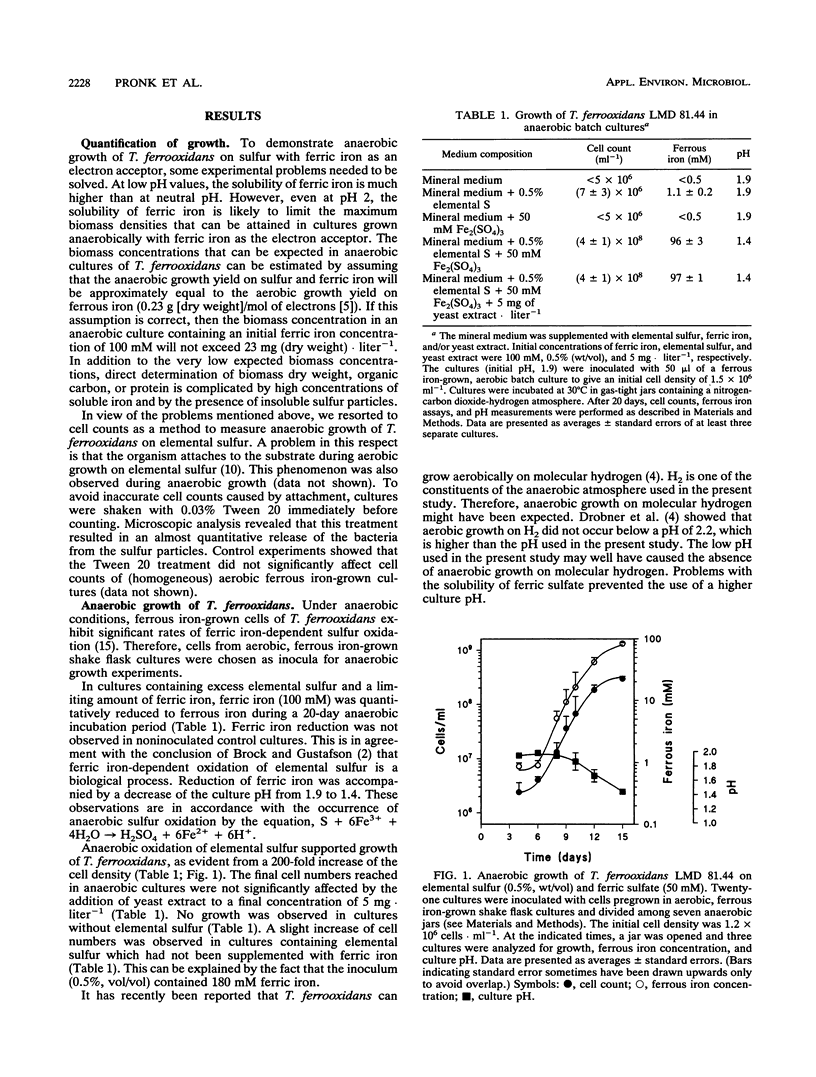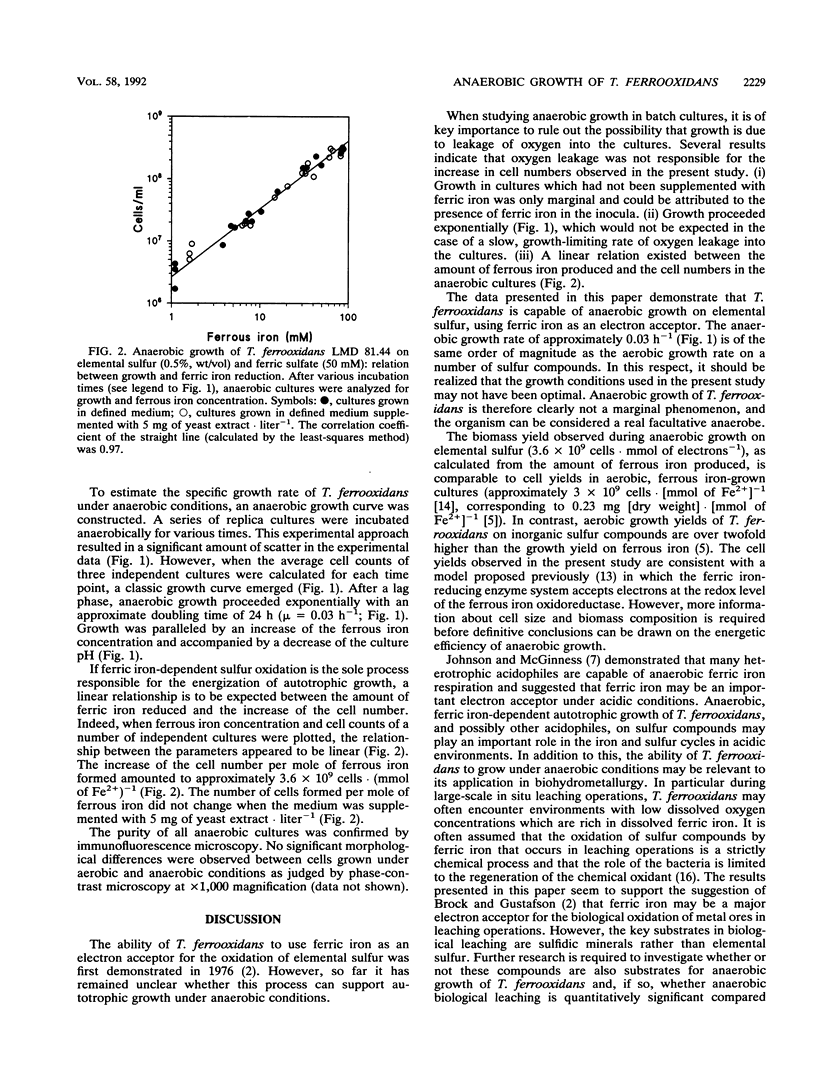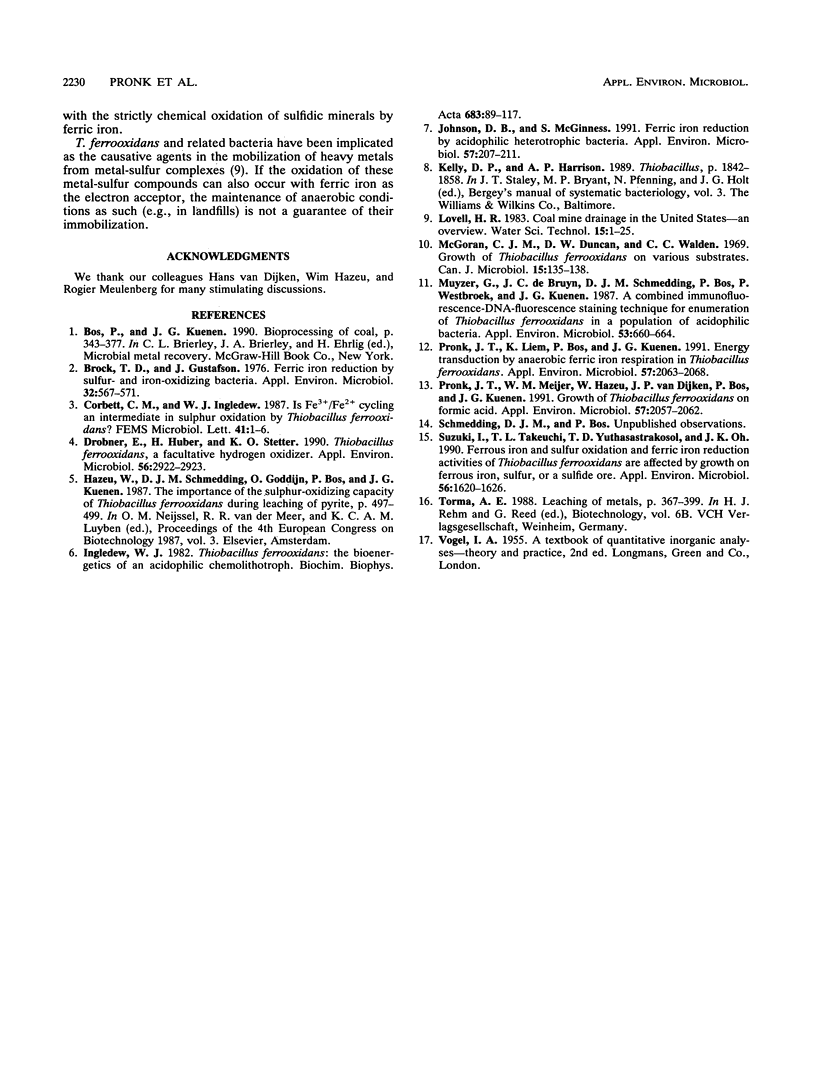Abstract
The obligately autotrophic acidophile Thiobacillus ferrooxidans was grown on elemental sulfur in anaerobic batch cultures, using ferric iron as an electron acceptor. During anaerobic growth, ferric iron present in the growth media was quantitatively reduced to ferrous iron. The doubling time in anaerobic cultures was approximately 24 h. Anaerobic growth did not occur in the absence of elemental sulfur or ferric iron. During growth, a linear relationship existed between the concentration of ferrous iron accumulated in the cultures and the cell density. The results suggest that ferric iron may be an important electron acceptor for the oxidation of sulfur compounds in acidic environments.
Full text
PDF



Selected References
These references are in PubMed. This may not be the complete list of references from this article.
- Brock T. D., Gustafson J. Ferric iron reduction by sulfur- and iron-oxidizing bacteria. Appl Environ Microbiol. 1976 Oct;32(4):567–571. doi: 10.1128/aem.32.4.567-571.1976. [DOI] [PMC free article] [PubMed] [Google Scholar]
- Drobner E., Huber H., Stetter K. O. Thiobacillus ferrooxidans, a facultative hydrogen oxidizer. Appl Environ Microbiol. 1990 Sep;56(9):2922–2923. doi: 10.1128/aem.56.9.2922-2923.1990. [DOI] [PMC free article] [PubMed] [Google Scholar]
- Ingledew W. J. Thiobacillus ferrooxidans. The bioenergetics of an acidophilic chemolithotroph. Biochim Biophys Acta. 1982 Nov 30;683(2):89–117. doi: 10.1016/0304-4173(82)90007-6. [DOI] [PubMed] [Google Scholar]
- Johnson D. B., McGinness S. Ferric iron reduction by acidophilic heterotrophic bacteria. Appl Environ Microbiol. 1991 Jan;57(1):207–211. doi: 10.1128/aem.57.1.207-211.1991. [DOI] [PMC free article] [PubMed] [Google Scholar]
- McGoran C. J., Duncan D. W., Walden C. C. Growth of Thiobacillus ferrooxidans on various substrates. Can J Microbiol. 1969 Jan;15(1):135–138. doi: 10.1139/m69-024. [DOI] [PubMed] [Google Scholar]
- Muyzer G., de Bruyn A. C., Schmedding D. J., Bos P., Westbroek P., Kuenen G. J. A Combined Immunofluorescence-DNA-Fluorescence Staining Technique for Enumeration of Thiobacillus ferrooxidans in a Population of Acidophilic Bacteria. Appl Environ Microbiol. 1987 Apr;53(4):660–664. doi: 10.1128/aem.53.4.660-664.1987. [DOI] [PMC free article] [PubMed] [Google Scholar]
- Pronk J. T., Liem K., Bos P., Kuenen J. G. Energy Transduction by Anaerobic Ferric Iron Respiration in Thiobacillus ferrooxidans. Appl Environ Microbiol. 1991 Jul;57(7):2063–2068. doi: 10.1128/aem.57.7.2063-2068.1991. [DOI] [PMC free article] [PubMed] [Google Scholar]
- Pronk J. T., Meijer W. M., Hazeu W., van Dijken J. P., Bos P., Kuenen J. G. Growth of Thiobacillus ferrooxidans on Formic Acid. Appl Environ Microbiol. 1991 Jul;57(7):2057–2062. doi: 10.1128/aem.57.7.2057-2062.1991. [DOI] [PMC free article] [PubMed] [Google Scholar]
- Suzuki I., Takeuchi T. L., Yuthasastrakosol T. D., Oh J. K. Ferrous Iron and Sulfur Oxidation and Ferric Iron Reduction Activities of Thiobacillus ferrooxidans Are Affected by Growth on Ferrous Iron, Sulfur, or a Sulfide Ore. Appl Environ Microbiol. 1990 Jun;56(6):1620–1626. doi: 10.1128/aem.56.6.1620-1626.1990. [DOI] [PMC free article] [PubMed] [Google Scholar]


